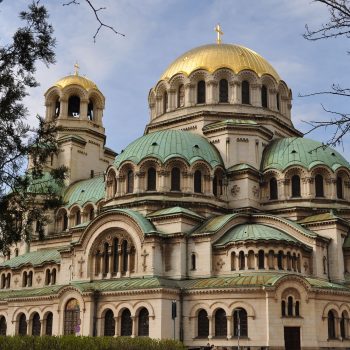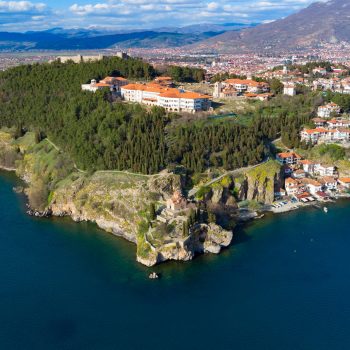After a substantial breakfast, check out and drive to the Serbian capital, Belgrade. Serbia has been independent from the former Serbia since 2006 and Montenegro.De capital of Serbia is Belgrade (Belgrade). A number of major cities in Serbia are: Kragujevac, Niš, Novi Pazar and Novi Sad. Serbia is known as a cultural country. There are many historic towns, castles, churches and beautiful nature. The landscape of Serbia is about half flat and the other half is mountainous. Serbia has several mountain areas with more than 15 mountains that reach above 2,000 meters. In addition, the country has several National parks and the River Danube. In the south of Serbia lies the autonomous province of Kosovo, known for the many wars that have taken place there.
With stunning views over the Danube and Sava rivers by the mighty medieval Belgrade Fortress, head to the heart of the capitol. Starting off at the vibrant pretty shopping street, Knez Mihailova, filled with cafes, shops and charming sites, kick off the walking tour to discover the incredible landmarks Belgrade has in store and their marvellous histories.
Highlights
Splavs (river clubs): Did you know that Belgrade is one of the best party cities in the world? The river clubs, or Splavs, are responsible for this. At the confluence of the two major rivers it is in the summer on the banks full of people. The parties in the Splavs usually start around midnight and last until early in the morning. There is a variety of music for everyone.
Concrete Hala: Concrete Hala is an urban river area near the Branko Bridge. It’s one of the coolest places to hang out. It can be an ideal place to relax after many visits. You’ll also find the better restaurants with international cuisine. Soak up the atmosphere and party with the live music that is played there.
St Sava Temple: St. Sava Temple is the second largest Orthodox church in the world. This temple is named after Sava, a Serbian monk from the 13th century. The Sava Temple stands on the hill Vracar. The construction of the temple began in 1935 and is one of the most striking buildings in the city. Also in the evening this temple is a delight to the eye when it is beautifully lit. Outside the church is a nice park with fountains.
Crkva Ruzica: Crkva Ruzica, or the Rose Church, is located on the Fort Kalemegdan. It is the oldest church in Belgrade. This rose church is dedicated to Mother of God. The Ruzica church was destroyed in 1521 by the invading Ottoman Turks and later used as a gunpowder warehouse. Inside the church you will soon see the chandeliers, made of weapons. They are great examples of war art.
Avala tower:The Avala tower stands on the Avalaberg on the outskirts of Belgrade. At 205 metres, it is the largest tower in Belgrade and the Balkans. The view at the top is breathtaking. On a beautiful, sunny day you have a great view up to 100 km around. It is a new tower since the old one was destroyed by a NATO bombardment in 1999, in this way the radio in Serbia had to be shut down. In 2008 the construction of a new tower began and a year later it was finished.
Nikola Tesla museum: Nikola Tesla is one of the people the Serbs are most proud of. This brilliant Serbian-American inventor, engineer and futurist, was known for developing modern alternating current electricity. In addition, he was also a pioneer in the discovery of X-ray technology, radar, remote control, electric coil and radio. In addition, the world’s most amazing electric car is named after him. The Nikola Tesla Museum contains all kinds of documents, books, drawings and photographs related to Tesla’s work.
Ada Ciganlija: Ada Ciganlija is a wooded river island. This popular place attracts crowds of holidaymakers in the summer. This peninsula is an oasis of numerous sports fields and long beaches. It is famous for its range of sports opportunities such as water sports, golf, rock climbing,… On the way back, be sure to take a picture of the impressive Ada Bridge, one of belgrade’s symbols.
Yugoslav Historical Museum: If you are interested in the fascinating history of Yugoslavia, then this is an absolute must. In the museum of Yugoslav history you will find an extraordinary collection of thousands of objects, historical documents, gifts, photographs, weapons and films from the Communist period. You’ll get a better view of what Yugoslavia was about.
Zemun: After the end of The First World War, Zemun officially became part of Serbia. Previously it was the southernmost city of the Austro-Hungarian Empire. With its narrow streets and well-preserved architecture, Zemun is a treat to explore on foot. The Danube Quay is just around the corner, with lots of nice restaurants where you can relax and enjoy the fresh breeze and the beautiful views.
Knez Mihailova: Do you like shopping? Then you’ll definitely have to go through this. Numerous shops, restaurants and bookshops are tucked away in Knez Mihailova’s stylish 19th-century buildings. Artists also make this street one of the most vibrant in the city.
Skadarlija: Skadarlija is a lively, cobbled street in the heart of Belgrade. There is still a typical Bohemian atmosphere. It was the meeting place for artists and artists. This place is therefore called the ‘Belgrade Montmartre’ for a reason. Nowadays you will find numerous restaurants, galleries, antique and souvenir shops.
Kalemegdan: Kalemegdan is the crown jewel of Belgrade. This most visited part of the city consists of the ancient citadel and the Kalemegdan park. From here you have a beautiful view of the Sava and the Danube. It is and remains the most favorite attraction among both tourists and locals. The citadel and surroundings are a cosy place with markets and restaurants.
Belgrade is never the same. It’s a city that never sleeps. A strong sense of freedom floats through the streets. Generous people are always there ready to help. It’s a city you should have seen.











